3 Tips To Make Your Design Easier
Joseph Casagrande / January 8th, 2019

The design process can be extremely fun to be a part of when done right.
There are some challenges, however, that will pop up along the way within the design process, and it’s essential that you’re ready for them.
Challenges like:
- Communicating with the customer
- Understanding the size or orientation of the piece
- Ensuring that the design layout is successful
As simple as these concepts may seem, executing them is a whole different story. Here are three easy tips to help you streamline the design process for your team and your customer.
1. Know What Your Customer Wants
Before starting any design, you must fully understand what the customer wants or has envisioned for the piece.
Many customers know what they want and aren’t afraid to tell you. When this is the case, your primary job is listening.
Once you’ve gathered all of the information from the customer, confirm and confirm again. Not only will it save you precious time and money later by making sure the piece is correct, but it also shows the customer that you are listening and that you care by taking the time to gather the information correctly.
Other customers do not know what they want and are looking to you for your expertise and direction.
When this happens, it gives you the opportunity to let your creative juices flow freely, and although many of us creatives love having this opportunity, be careful. It can be dangerous territory.
If the customer doesn’t like what you created, you’ll have to start the design all over again. To cut down on the chances of this happening, gather examples as to what they may want before actually beginning the design. This will save you and the customer a lot of time, keeping you from going back and forth.
Remember, effective communication with your customer is critical and will help you save time and money on design.
2. Understanding the Size and Orientation of the Piece
Once you’ve gathered the required information from your customer, it is important to have a full understanding of the size and orientation of what you are working on for the customer.
Customers may want a tri-fold brochure, a rack card, a business card or another print material. Knowing and understanding how the design will look, feel, and read according to the size and orientation is essential for your design.
Resist the urge to input the design dimensions into your software and plow ahead. Instead, carefully consider the parameters needed to understand the design fully.
Things to consider include:
- Where will the fold land in the design?
- How will the margins affect the design?
- If mailing, what adjustments need to be made, so the piece doesn’t get beat up in the mail?
Having this knowledge will help you understand how to set up a successful piece best.
3. What Makes for a Good Design?
Creating a successful design piece requires the understanding of how to create a clean, but attractive design.
Many rookie designers tend to think that all white space needs to be occupied by information or images. While over-designing may seem attractive at first, it creates a finished piece that is hard to read and confusing for the reader.
Remember, if the eye cannot move freely and comfortably on the piece, most of the information on the piece itself will be lost and ineffective. Be sure to focus on the organization of the information as overall structure and organization can make or break a piece.
Designing is a lot of fun, but print design isn’t your basic arts and crafts. You need to have effective communication between you and your customer, a full understanding of what the piece is, and how to create an attractive yet practical design.
Once you can nail these three steps down, you’ll have a much more comfortable design process.

